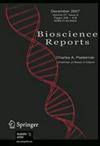Loss of cardiomyocyte-specific Adhesion G Protein Coupled Receptor G1 (ADGRG1/GPR56) promotes pressure overload-induced heart failure.
IF 4.7
3区 生物学
Q2 BIOCHEMISTRY & MOLECULAR BIOLOGY
引用次数: 0
Abstract
Adhesion G protein coupled receptors (AGPCRs), containing large N-terminal ligand-binding domains for environmental mechano-sensing, have been increasingly recognized to play important roles in numerous physiologic and pathologic processes. However, their impact on the heart, which undergoes dynamic mechanical alterations in healthy and failing states, remains understudied. ADGRG1 (formerly known as GPR56) is widely expressed, including in skeletal muscle where it was previously shown to mediate mechanical overload-induced muscle hypertrophy, thus we hypothesized that it could impact the development of cardiac dysfunction and remodeling in response to pressure overload. In this study, we generated a cardiomyocyte (CM)-specific ADGRG1 knockout mouse model, which, although not initially displaying features of cardiac dysfunction, does develop increased systolic and diastolic LV volumes and internal diameters over time. Notably, when challenged with chronic pressure overload, CM-specific ADGRG1 deletion accelerates cardiac dysfunction, concurrent with blunted CM hypertrophy, enhanced cardiac inflammation and increased mortality, suggesting that ADGRG1 plays an important role in the early adaptation to chronic cardiac stress. Altogether, this study provides an important proof-of-concept that targeting CM-expressed AGPCRs may offer a new avenue for regulating the development of heart failure.心肌细胞特异性粘附G蛋白偶联受体G1(ADGRG1/GPR56)的缺失会促进压力过载引起的心力衰竭。
粘附 G 蛋白偶联受体(AGPCR)含有用于环境机械感应的大 N 端配体结合域,越来越多的人认识到它们在许多生理和病理过程中发挥着重要作用。然而,它们对心脏的影响仍未得到充分研究,因为心脏在健康和衰竭状态下都会发生动态机械变化。ADGRG1(以前称为 GPR56)广泛表达,包括在骨骼肌中的表达,在骨骼肌中它曾被证明介导机械过载诱导的肌肉肥大,因此我们假设它可能会影响心脏功能障碍的发展和压力过载下的重塑。在这项研究中,我们建立了一个心肌细胞(CM)特异性 ADGRG1 基因敲除小鼠模型,该模型虽然最初没有表现出心功能不全的特征,但随着时间的推移,收缩期和舒张期左心室容积和内径确实会增大。值得注意的是,当受到慢性压力过载的挑战时,CM 特异性 ADGRG1 基因缺失会加速心功能不全,同时出现 CM 肥大减弱、心脏炎症增强和死亡率升高,这表明 ADGRG1 在早期适应慢性心脏压力方面发挥着重要作用。总之,这项研究提供了一个重要的概念证明,即靶向 CM 表达的 AGPCR 可为调控心力衰竭的发展提供一条新途径。
本文章由计算机程序翻译,如有差异,请以英文原文为准。
求助全文
约1分钟内获得全文
求助全文
来源期刊

Bioscience Reports
生物-细胞生物学
CiteScore
8.50
自引率
0.00%
发文量
380
审稿时长
6-12 weeks
期刊介绍:
Bioscience Reports provides a home for sound scientific research in all areas of cell biology and molecular life sciences.
Since 2012, Bioscience Reports has been fully Open Access and publishes all papers under the liberal CC BY licence, giving the life science community quality research to share and discuss.Content before 2012 is subscription-only, and is accessible via archive purchase.
Articles are assessed on soundness, providing a home for valid findings and data.
We welcome papers that span disciplines (e.g. chemistry, medicine), including papers describing:
-new methodologies
-tools and reagents to probe biological questions
-mechanistic details
-disease mechanisms
-metabolic processes and their regulation
-structure and function
-bioenergetics
 求助内容:
求助内容: 应助结果提醒方式:
应助结果提醒方式:


